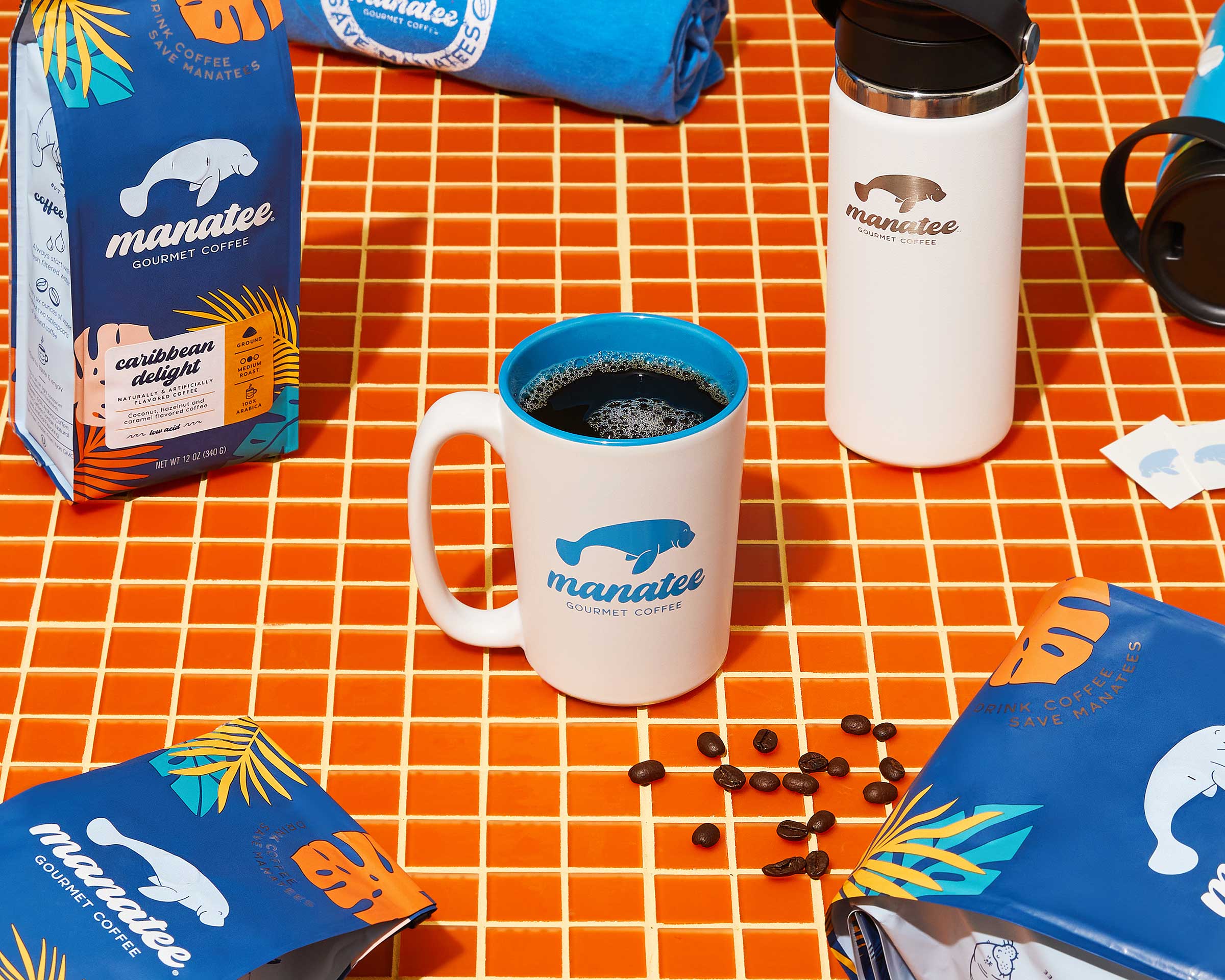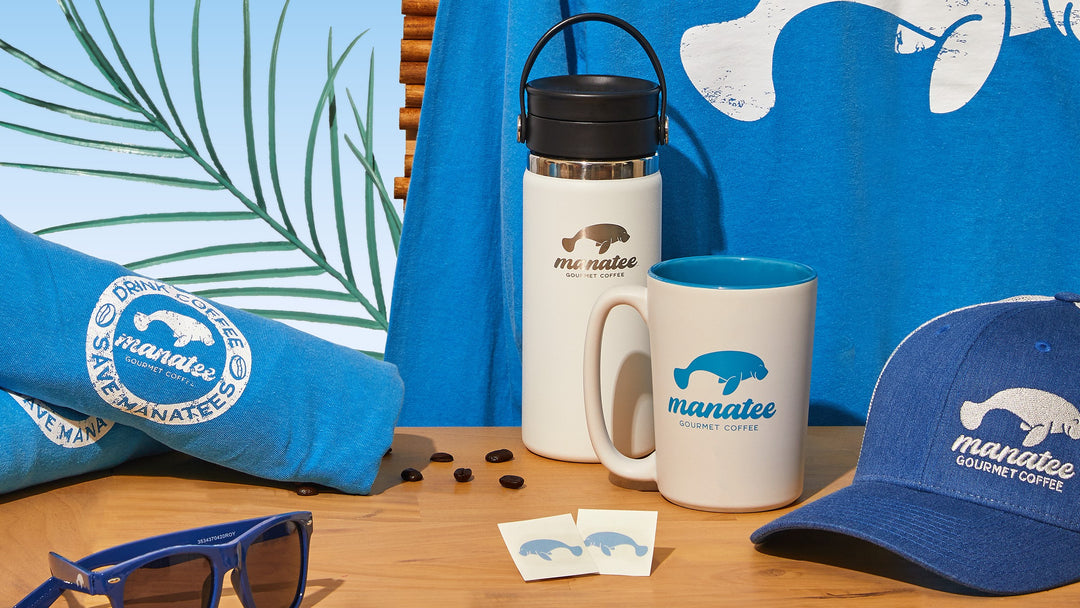We all enjoy our morning cup of coffee for different reasons. Whether it’s the captivating aroma, the uniquely smooth taste of Manatee Coffee, or the proven health benefits, there is one naturally occurring substance in every cup of coffee that keeps people coming back for more: CAFFEINE. If coffee is an essential part of your daily routine, you may have wondered, “What is the average amount of caffeine in a cup of coffee?”
Most likely (if you are reading these words), you are numbered among the over 60% of Americans who drink coffee daily. Earlier today, you probably reached for a mugful of piping hot coffee bliss, or you drank a chilled Cold Brew of liquid love.
People usually drink coffee for its stimulating properties. The “boosted wakefulness and alertness” from the caffeine we all know and love comes from our bodies creating dopamine and noradrenaline. However, people respond to and metabolize caffeine differently. The release of these chemicals has different effects depending on your body type, body size, blood sugar level, metabolism, medications, and heredity.
However, before we explain how much caffeine is healthy to consume each day and how much caffeine is in a cup of coffee, here are a few facts about coffee and caffeine:
- Over 150 million Americans drink 400 million cups of coffee every day
- Caffeine occurs naturally in the leaves and fruit of over 60 different plants
- Coffee and tea are the most widely consumed caffeinated beverages worldwide
- Tea leaves have more caffeine gram-for-gram than the caffeine in coffee beans
- Tea has less caffeine than coffee due to the volume of beans used when brewing
- After consuming caffeinated coffee, it takes 30-60 minutes to affect the brain
- Coffee increases the heart rate for about 4 hours with mood-enhancing effects
What Amount of Caffeine Is Healthy to Drink?
How much caffeine is too much to drink every day? The world’s most influential food agencies recommend drinking no more than 400 milligrams of caffeine per day (or 200 milligrams if you are pregnant or breastfeeding), which is “not associated with overt, adverse effects” in average adults. But how many cups of coffee contain 400 milligrams of caffeine?
How Many Cups of Coffee Is 400 mg of Caffeine?
While the actual amount of caffeine in a regular cup of coffee will vary significantly depending on different factors, on average there are about 400 milligrams of caffeine in three to four 8 oz cups of coffee. You will get about the same amount of caffeine from five to six energy drinks or eight to nine cups of Black Tea. So the biggest bang for your buck will come from caffeinated coffee!
As with all things in life, moderation is key. And given the 400-milligram daily guideline, it might be wise to limit the number of cups of coffee you drink every day (especially if you drink coffee with higher amounts of caffeine). Also remember to count the caffeine from every source, including your medications, the chocolate you enjoy, etc.
With that said, caffeine consumption guidelines are simply just “suggested guidelines” and not mandates. As mentioned above, personal effects from caffeine vary depending on body weight, lifestyle, individual sensitivities, and medical needs. If you have questions about how caffeine might affect you personally, please consult your doctor or a certified medical professional.
What Affects Caffeine Levels in Coffee?
Calculating the caffeine content in coffee is not an exact science because coffee beans vary too much from year to year (soil, sun, rain, and altitude all play a role). Differing roasts and brewing methods also contribute to a variety of caffeine levels. But three main factors contribute to the amount of caffeine in your cup.
Factor 1: Type of Coffee Beans
Different coffee beans have different levels of caffeine. For example, Arabica beans, which we use in all Manatee Coffee for its uniquely smooth taste, have half the caffeine of Robusta beans.
Factor 2: Level of Coffee Roast
While this may seem counterintuitive to some, the longer and darker we roast our coffee beans, the less caffeine remains in the beans after being cooked out during the roast. Conversely, the lighter we roast our coffee beans, the higher the level of caffeine.
Factor 3: Kind of Coffee Brew
The brewing method also affects caffeine. From Whole Bean coffee finely ground for highly-caffeinated espresso-based drinks to coffee drip-brewed from Ground or Single Cup, or Decaf where only 1%–3% of the caffeine remains—brewing matters.
How Much Caffeine Is in a Cup of Manatee?
An average 8 oz cup of Manatee Coffee has between 90–100 milligrams of caffeine. As we shared above and elsewhere about Medium Roast and Dark Roast Coffee, darker roasts have lower caffeine, and lighter roasts have higher caffeine. But roughly speaking, on average our Dark Roast has around 90 milligrams and our Medium Roast has about 100 milligrams of caffeine.
While all of the factors above are involved in making up the caffeine content in a cup of coffee, we based our numbers on a standard, pour-over method of brewing coffee. Keep in mind that the longer you pour hot water over your coffee and the finer the grind will both contribute to the caffeine level in your cup. It is why espresso-based drinks typically have a higher concentration of caffeine per serving due to their brewing method and the density of coffee. For example, one 2 oz Double Espresso shot has about 80 milligrams of caffeine. However, most Americans typically drink 8 oz of coffee or more.
How Much Caffeine Is in Decaffeinated Coffee?
While some people might think the name “Decaf” (short for decaffeinated) means removing all the caffeine from the coffee—this is a misconception. Since caffeine naturally occurs in all coffee beans, no natural Whole Bean or Ground coffee can ever be 100% caffeine-free. Most decaffeination processes remove between 97%-99% of caffeine (leaving about 3 milligrams). However, the FDA only requires 97% of the caffeine to be removed to be officially considered decaffeinated.
SOURCES
- Caffeine: Explained by James Hoffmann
- The Buzz About Caffeine by Food Insight
- Nervous About Caffeine? Don’t Be. by NCA Blog
- Coffee and Health by NCA USA









